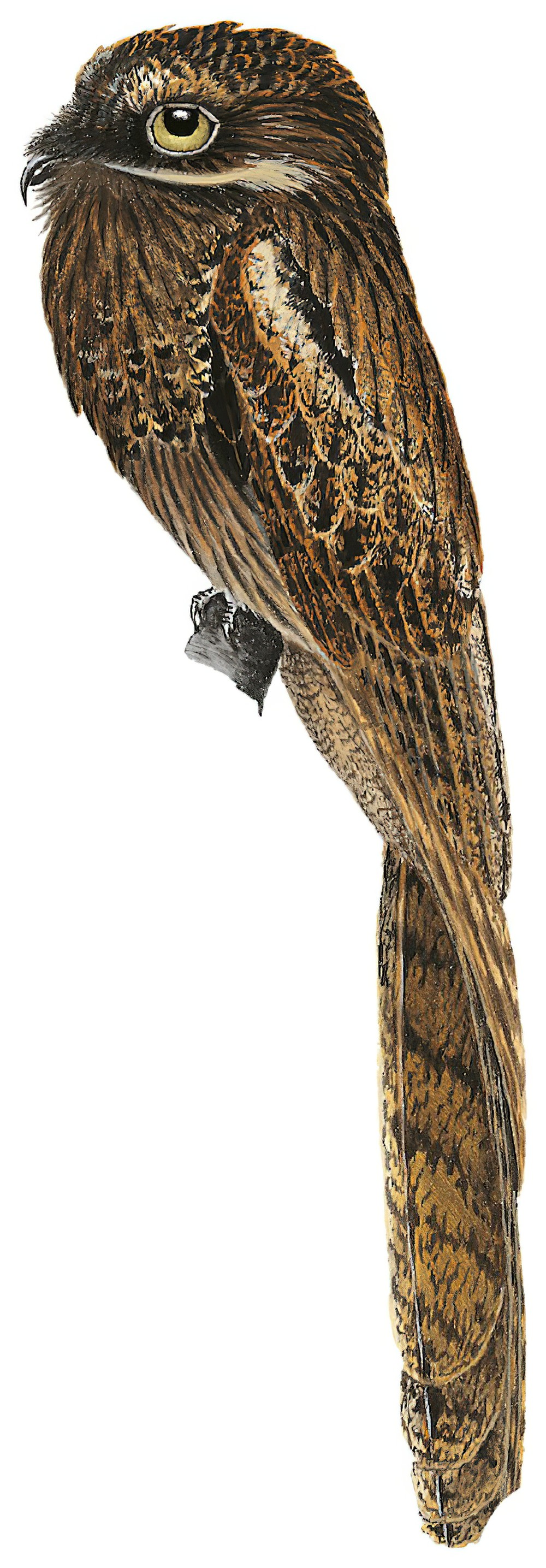Long-tailed Potoo / Nyctibius aethereus

Long-tailed Potoo
SCI Name:
Protonym: Caprimulgus aethereus ReiseBrasil. 1 p.236,note
Taxonomy: Caprimulgiformes / Nyctibiidae / Nyctibius
Taxonomy Code: lotpot1
Type Locality: Rio Mucuri [Macure], Bahia.
Author: zu Wied-Neuwied
Publish Year: 1820
IUCN Status: Least Concern
DEFINITIONS
NYCTIBIUS
(Nyctibiidae; Ϯ Great Potoo N. grandis) Gr. νυκτιβιος nuktibios night-feeding < νυξ nux, νυκτος nuktos night; βιοω bioō to live; "110. IBIJAU, Nyctibius. Caprimulgus, Linn. Gm. Lath. Bec très-dilaté et garni de soies à la base, rétréci et crochu à la pointe; mandibule supérieure munie sur les côtés, vers son origine, d'une dent obtuse; l'inférieure plus large, à bords recourbés en dehors. — Doigts antérieurs unis à l'origine par une petite membrane; latéraux inégaux; pouce épaté. Esp. Grand Engoulevent de Cayenne, Buff. ... Nyctibius [νυκτιβιος, noctu victum quærens]." (Vieillot 1816); "Nyctibius Vieillot, Analyse, 1816, p. 38. Type, by monotypy, Grand Engoulevent de Cayenne, Buffon = Caprimulgus grandis Gmelin." (Peters 1940, IV, 179).
Var. Nictibius, Nyctitrius.
Synon. Ibijus, Nyctornis, Phyllaemulor, Selochusa.
aethereus
L. aetherius on high, of the air, heavenly < aether, aetheris upper air, heaven < Gr. αιθηρ aithēr, αιθερος aitheros ether, heaven.
● Epithet given to the Large-tailed Potoo because it is supposed to rise high in the air and hover like a falcon; “welch ich C. aethereus nannte, da er bis zu einer bedeutenden Höhe in die Luft steigt, und dort gleich einem Falken schwebend steht” (zu Wied-Neuwied 1820) (Nyctibius).
● “It is called the Tropic-bird because it is found about the Latitude of the Tropic circles, and no where else, so far as hath been by our English Travellers hitherto observed” (Ray 1678); "67. PHAËTHON. ... æthereus. 1. PH. rectricibus duabus longissimis, rostro serrato, digito postico adnato. Avis tropicorum. Catesb. car. 3. p. 14. t. 14. Raj. av. 123. Will. orn. 250. t. 76. Edw. av. 149. t. 149. f. 1. Sloan. jam. I. p. 22. Kalm. iter. 2. p. 149. Osb. iter. 291. Avis Rabos forcados. Aldr. orn. l. 20. p. 544. Habitat in Pelago inter tropicos. Osbeck. Magnitudo Anatis, alba supra lineis nigricantibus undulata tota; subtus immaculata. Fascia nigra per oculos. Rostrum sanguineum, compressum, rectius quam P. Piscatoris, retrorsum serratum. Pedes pallidi, extrorsum nigri, digito quarto etiam membrana affixo. Remiges omnes subtus albæ: primores supra latere exteriore nigræ; secundariæ supra linea longitudinali nigra. Rectrices albæ in cauda cuneiformi, versus apicem lineola subsagittata fusca; omnes supra rachi nivea." (Linnaeus 1758) (Phaethon).
SUBSPECIES
Long-tailed Potoo (chocoensis)
SCI Name: Nyctibius aethereus chocoensis
chocoana / chocoanus / chocoensis
Chocó Dept., Colombia (“Chocó region, an important center of endemism, from Cerro Pirre, easternmost Panama, south through western Colombia to extreme north-western Ecuador” (Krabbe & Schulenberg 1997)).
Long-tailed Potoo (longicaudatus)
SCI Name: Nyctibius aethereus longicaudatus
longicaudata / longicaudatus
L. longus long; caudatus tailed < cauda tail.
Long-tailed Potoo (aethereus)
SCI Name: Nyctibius aethereus aethereus
aethereus
L. aetherius on high, of the air, heavenly < aether, aetheris upper air, heaven < Gr. αιθηρ aithēr, αιθερος aitheros ether, heaven.
● Epithet given to the Large-tailed Potoo because it is supposed to rise high in the air and hover like a falcon; “welch ich C. aethereus nannte, da er bis zu einer bedeutenden Höhe in die Luft steigt, und dort gleich einem Falken schwebend steht” (zu Wied-Neuwied 1820) (Nyctibius).
● “It is called the Tropic-bird because it is found about the Latitude of the Tropic circles, and no where else, so far as hath been by our English Travellers hitherto observed” (Ray 1678); "67. PHAËTHON. ... æthereus. 1. PH. rectricibus duabus longissimis, rostro serrato, digito postico adnato. Avis tropicorum. Catesb. car. 3. p. 14. t. 14. Raj. av. 123. Will. orn. 250. t. 76. Edw. av. 149. t. 149. f. 1. Sloan. jam. I. p. 22. Kalm. iter. 2. p. 149. Osb. iter. 291. Avis Rabos forcados. Aldr. orn. l. 20. p. 544. Habitat in Pelago inter tropicos. Osbeck. Magnitudo Anatis, alba supra lineis nigricantibus undulata tota; subtus immaculata. Fascia nigra per oculos. Rostrum sanguineum, compressum, rectius quam P. Piscatoris, retrorsum serratum. Pedes pallidi, extrorsum nigri, digito quarto etiam membrana affixo. Remiges omnes subtus albæ: primores supra latere exteriore nigræ; secundariæ supra linea longitudinali nigra. Rectrices albæ in cauda cuneiformi, versus apicem lineola subsagittata fusca; omnes supra rachi nivea." (Linnaeus 1758) (Phaethon).
UPPERCASE: current genus
Uppercase first letter: generic synonym
● and ● See: generic homonyms
lowercase: species and subspecies
●: early names, variants, mispellings
‡: extinct
†: type species
Gr.: ancient Greek
L.: Latin
<: derived from
syn: synonym of
/: separates historical and modern geographic names
ex: based on
TL: type locality
OD: original diagnosis (genus) or original description (species)












